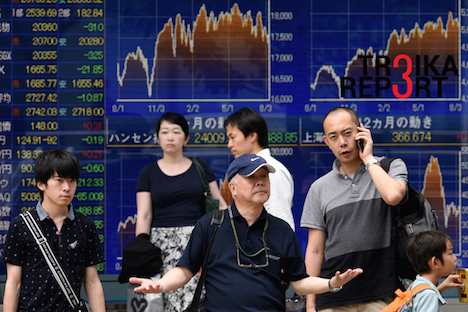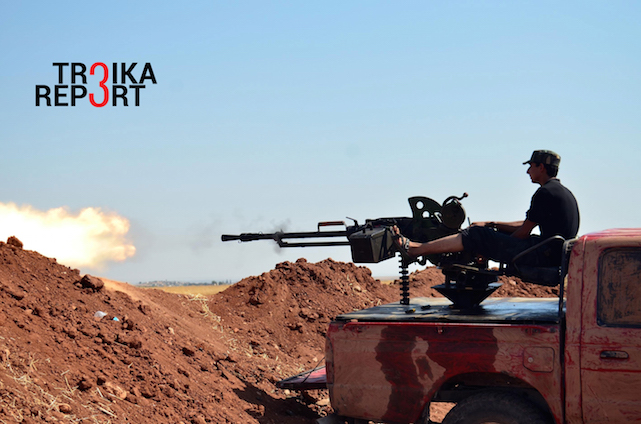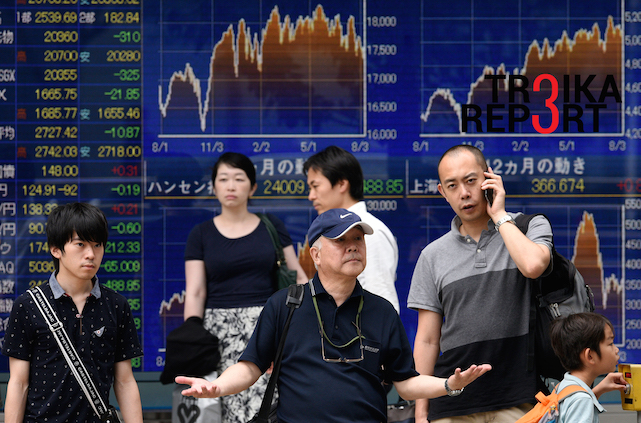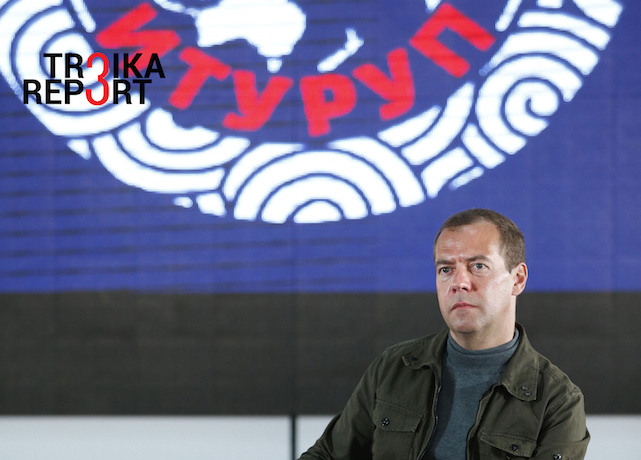

Members of Syrian opposition group linked to the Damascus Front (Shamiyya Front) launch attacks with heavy weapons on Daesh targets around the gas facilities in Aleppo's northern district of Azez, Syria, Aug. 17, 2015. Source: Getty Images
This week’s passing of a resolution by the UN Security Council, calling for an investigation into the use of chlorine and other chemicals in attacks in Syria, was a rare example of the U.S. and Russia cooperating in full and in good spirit. Despite diverging views on the origins of the civil war in Syria and on strategies to resolve the conflict, the two nations are in full accord that the use and spread of weapons of mass destruction is unacceptable.
For the record, the resolution was endorsed unanimously by the 15-member Council, and the Hague-based Organization for the Prohibition of Chemical Weapons is now initiating the investigation process.
The alarm was raised when a spokesman for Iraqi Kurd paramilitary forces reported victims of an ISIS attack who presented with “blisters” that matched the symptoms of exposure to mustard gas. The Kurdish report said that ISIS had fired 45 mortars carrying chemical warheads.
Officials in Washington have good reasons to be concerned. Senator Joni Ernst from the State of Iowa expressed apprehension that chemical weapons could be used not only on the Peshmerga units of the Iraqi Kurds but on American officers and soldiers serving as military instructors for Iraqi government troops.
Back in 2004, the Sunni rebels in Iraq, in desperation at having been stripped of the dominant position they enjoyed under Saddam Hussein, launched an attack on U.S. occupation forces, occasionally using mustard gas-filled artillery shells.
Remarkably, a U.S. official has told Fox News the mustard agent used against Kurds now was “homemade” and did not originate in Syria. Recently, experts claimed that ISIS may have up to 200 tons of mustard gas at their disposal.
A proper investigation would reveal the truth, just as it did in 2013. According to the final report of the United Nations Mission to investigate allegations of the use of chemical weapons in Syria, dated Dec. 13, 2013, the attacks carried out on March 19, Aug. 24 and Aug. 25 that year upon Syrian government soldiers indicate that the rebels were in possession of sarin both before and immediately after the chemical weapon attack at Ghouta on Aug. 21, 2013.
Russian experts conducted analysis of their own and concluded that for the attack near Aleppo on March 19 “home-made” sarin gas had been used.
This time Russia has voted for a comprehensive investigation under the auspices of the United Nations while cooperating on the wording of the resolution with the U.S.
Could this be interpreted as a positive sign of diplomatic engagement on a dossier which is still divisive for Moscow and Washington? Sergei Oznobishev, director of the Institute of Strategic Assessment, a Moscow-based independent think-tank, had this to say to Troika Report:
“Despite the Ukrainian crisis and despite the negative background of our relations, Russia has always said that it stands for broad cooperation on common threats and challenges. Before the present crisis, a fine example of our cooperation was on the destruction of Syrian chemical weapons. On many occasions Moscow stated that it was against the distribution of weapons of mass destruction.
“Cooperation with the United States on the chemical weapons dossier could help make bilateral relations, which are in a dire state, constructive and, hopefully, in some areas even friendly.”
If the apparent chemical attacks by ISIS militants are authenticated, it might persuade the Obama administration to get more involved in fighting the anti-Western extremists, testing the water for a possible ground operation. Should it come to that, the United States would find itself in the somewhat ambiguous position of being an unwilling ally of the Syrian regime of President Bashar al-Assad, whom it has dreamed of toppling for years.
The likelihood that American troops would be fighting both ISIS and Assad’s forces is remote. It would mean antagonizing Iran right after a landmark deal on its nuclear program and further aggravating relations with Russia already strained to the limit over the hostilities in Ukraine.
It is more plausible that for the duration of the anti-ISIS offensive the fate of the Syrian leader would be put on hold, pending the outcome of the war against a common enemy of the U.S. and Russia. By that time, the ongoing diplomatic maneuvers might have produced a face-saving solution for all stakeholders.

Pedestrians stand before a markets indicator board in Tokyo, Japan, Aug. 12, 2015. Tokyo stocks dropped after China's central bank devalued the yuan for the second time in two days, to aid a slowing economy. Source: EPA
The creeping effects of the devaluation of the yuan, the crash of China’s stock exchange and the accumulation of negative trends in the world’s second-largest economy has fueled speculations in the Moscow expert community that the timing of Russia’s declared “pivot to Asia” — with its emphasis on strategic partnership with China — might have been wrong.
The depreciation of the Chinese currency took everyone by surprise, triggering suspicions that these are the first shots in a currency war. However, one can convincingly argue that despite relatively small damage from the economic slowdown, at least, so far, China is fidgety since its previous growth drivers — export-oriented manufacturing sectors, real estate and investments in infrastructure projects — are no longer delivering as they did before.
One of the main reasons is the gradual drying up of the stream of migrant workers from rural areas. Since Deng Xiaoping launched his reforms back in 1978, some 278 million people have moved into China’s cities – most with moderate life aspirations and ready to accept modest remunerations. In 2014, the inflow shrank to 1.3 percent, and this year it may even go into the red. China has to accommodate more skilled and more demanding laborers, which inevitably ramps up wages and salaries across all key industries.
Subsequently, a more expensive workforce deprives China of its ultimate competitive advantage, which fueled its sustainable GDP growth at an average of 10 percent until 2010. It peaked in 2007 with an awesome 14.2 percent of added GDP value. However, by 2014 it had slowed to 7.4 percent, the country’s worst performance in the last 24 years. The final outcome of 2015, despite official forecasts of “around 7 percent” GDP growth, according to the general assessment, will amount to a maximum of around 4-5 percent.
The meltdown of the Chinese economy has sent shockwaves around the world’s financial markets, while experts are struggling to forecast its global impact. How serious is this downturn? What echoes will all these adverse developments in China have in Russia? Alexander Zotin, an observer with leading Russian business weekly Money, had this to say to Troika Report:
“Chinese GDP constitutes 10-12 percent of global GDP. But the Chinese share of global GDP growth is more than 33 percent, or a third. China has been the leader of global growth for the last 10 or even 20 years. Now, if China ceases to be that leader, the world will be stagnating.”
“Now we see the effects of an unstable growth model. We see the bubble on the stock market and in real estate. It means a strong headwind. For the outside world, it will mean difficult times ahead while trying to alleviate the effects of the Chinese slowdown.”
— How will Russia be affected by the adverse trends in the Chinese economy?
“The Russian economy is 75 percent dependent on the export of commodities. Two thirds of Russian exports is made up of oil and gas, plus 15 percent for industrial metals. The Chinese slowdown will depress prices for these commodities.”
“Russia is very dependent on global economic cycles. If the world’s economy is booming, Russia’s economy is also booming. If the trend is negative, Russia’s economy is contracting at an even higher rate. Russia is hypersensitive to growth cycles.”
What are the immediate repercussions of China’s slowdown and currency volatility for Russia? The alarm bells began ringing this year when the negotiations over the Western route to deliver pipeline gas to China (the Power of Siberia 2 project) started to drag their feet. While work on the eastern route project to bring 38 billion cubic meters per annum (bcma) of Siberian natural gas to China is underway, the original offer to supply an additional 30 bcma via the Altai region to China’s western regions has now become less attractive.
The reason is that while in 2012-2013 gas consumption in China surged by 12-13 percent, the rate of growth fell to 8.5 percent in 2014, and was reduced to 2 percent in the first quarter of 2015. The global oil price crunch was no less instrumental in stalling the talks.
This bearish trend might also affect purchases of goods with high added value, inflicting damage on countries like Germany, which exports sophisticated equipment and technology to its major trade client in the East. With deflationary pressure from China building up, the German economy would suffer as well.
Follow the logic: Since Germany is the key trade and economic partner of Russia, for Russian businesses there will be a spillover of troubles both from the east and the west – the classic “domino effect.”
Actually, this is the price to pay for globalization, which has enhanced the risks of interdependence to a level beyond anyone’s control. One Russian expert predicts that the next global recession will be “Made in China,” or at least in the coming years the Asian behemoth will be the single biggest source of global economic volatility.

Russian Prime Minister Dmitry Medvedev meets the participants of the Russian Youth Education Forum Iturup in the town of Kurilsk. The Russian Prime Minister came to Iturup, one of the Kuril Islands, during his visit to the Far Eastern Federal District. Source: Ria Novosti/Dmitry Astakhov
Japanese leadership was upset by Russian Prime Minister Dmitry Medvedev setting foot on the island of Iturup of the Kuril archipelago in the Russian Far East last week. Seized by the USSR in 1945, the Kurils remain a bone of contention between the two countries and Japan continues to claim the four southernmost islands. As a symbolic rebuff to Medvedev’s visit, the Japanese foreign minister delayed his trip to Moscow.
Medvedev’s visit and his statement that the Kurils are an integral and natural part of Russia — “This is how it is and how it will be” — has jeopardized if not ruined altogether the chances of a pre-planned visit to Tokyo and summit between Shinzo Abe, Japan’s prime minister, and Russian President Vladimir Putin.
What is the price that Moscow seems to be so ready to pay for alienating Japan prior to much-anticipated high-level talks? Vladimir Skosyrev, a foreign affairs observer with Nezavisimaya Gazeta in Moscow, made this comment for Troika Report:
“I am a little astonished by the tough stance by Moscow. There are no chances of Russia giving away the islands to Japan in the foreseeable future. I do not understand why it is necessary for our prime minister to visit the island of Iturup at this very moment. We are facing hostile attitudes from the Western powers. Japan had a slightly milder position (regarding Russia). We are interested in Japanese investments. President Putin’s visit to Japan could have improved our relations. It could also lessen Russia’s dependence on China. Medvedev’s visit to Iturup shows that Moscow is not counting on positive results from Putin’s trip to Japan.”
— It looks like Russia’s “pivot to Asia” is becoming predominantly a pivot to China. Can this strategy succeed without positively engaging Japan?
“I think this so-called ‘pivot to Asia’ is not a very good move. We are becoming more and more dependent on China. We should seek some counterweight to China’s influence. Japan could be one of the possible players in this game. But we reject any possibility of improving relations with Tokyo.”
Russia’s stance is based on the premise that, given the extremely sensitive nature of the controversy, it makes sense to detach business from politics, leaving the settlement of the territorial dispute for subsequent generations.
Whoever follows the logic of horse sense would ask several crucial questions about the future of the turbulent relations between Russia and Japan.
Can Russia’s solemnly proclaimed strategy of a “pivot to Asia” succeed without a positive engagement of Japan? The answer is: no.
Given the potential of Russia-China cooperation, can Japan afford to stay on the sidelines of the new integration process that is gearing up in Eurasia? No.
Is it a genuine belief among the Japanese political class that the return of the disputed Kuril Islands would bury the hatchet of World War II and set bilateral ties on the path to peace and prosperity? No.
Do policy makers in Japan think that – regardless of whatever leader is in power in Moscow – the “giveaway” of part of Russia’s territory would earn support with the Russian public? No.
Now let’s try a set of positive answers. If the territorial dispute remains in total stalemate, will it adversely affect political and business cooperation between the two neighboring countries? Yes, it will.
In this case, will it deprive Russia and Japan of the benefits of meaningful and profitable interaction? Yes.
Will the prolonged discord persuade Russia to enhance ties and bet on a strategic (non-military) alliance with China, while convincing Japan it has no option but to keep its attachment to the United States? Yes. It brings both sides nowhere nearer a compromise. As The Financial Times pointed out, “the strength of Japan’s U.S. alliance gives Russia little incentive to make concessions.”
True, Shintaro Abe, the father of Japan’s current prime minister, made an attempt to resolve the frozen diplomatic conflict while serving as foreign minister back in the 1980s. It fell flat.
Today, his son, who seems to enjoy a special relationship with Vladimir Putin, is keen to achieve a breakthrough. It was reported that Abe was even considering attending the festivities in May in Moscow dedicated to the 70thanniversary of the Allied victory over the Axis powers in 1945. Rumor has it that the Russian president is interested in finding a sound solution to the dispute over the Kurils.
The bottom line of these logical calculations is that entrenched misunderstanding and animosity which is keeping Japan and Russia apart is beneficial to neither of them. For Moscow and Tokyo, the insurmountable obstacle in the form of the Kuril Islands dispute remains a classical lose-lose situation.
The opinion of the writers may not necessarily reflect the position of RBTH or its staff.
All rights reserved by Rossiyskaya Gazeta.
Subscribe
to our newsletter!
Get the week's best stories straight to your inbox